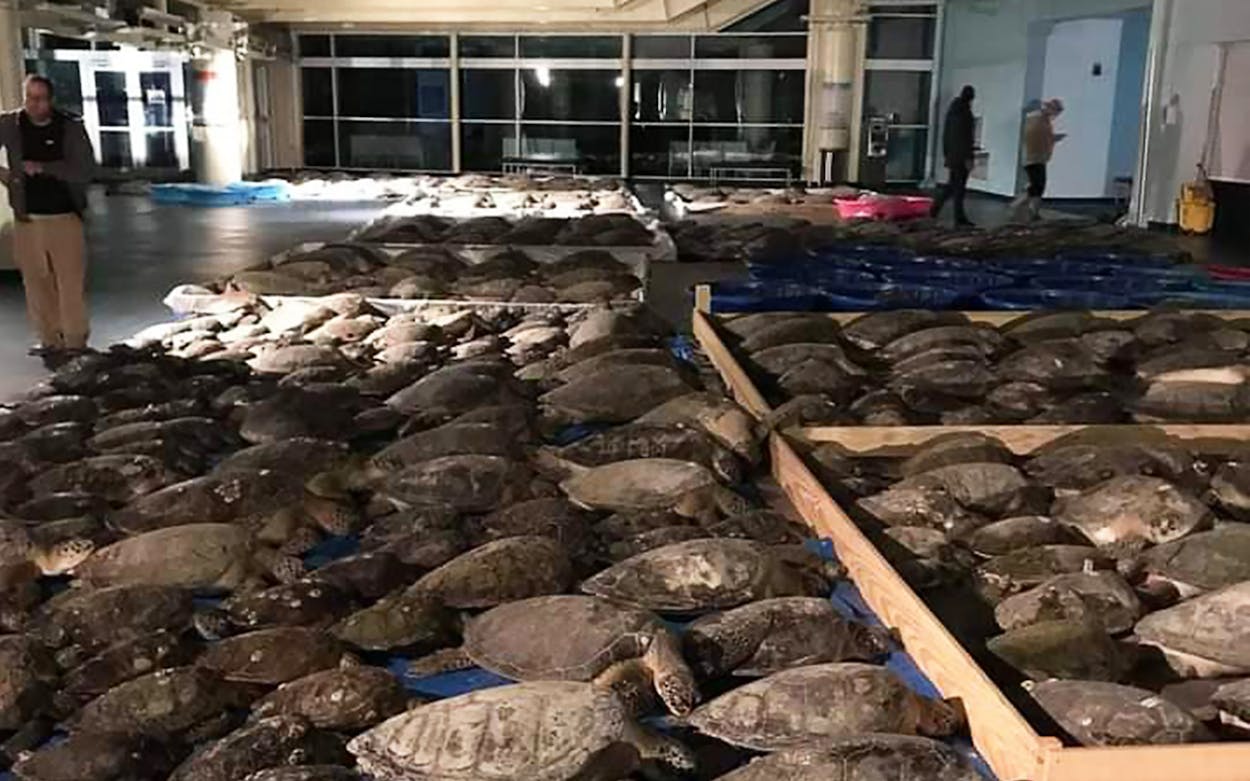Henry Rodriguez usually spends his days showing dolphins to tourists and helping fishermen reel in their catch. But on Sunday, the owner of Henry’s Charters on South Padre Island headed to the channels between the Laguna Madre and Isla Blanca Park and began scooping up cold-stunned sea turtles.
That first day, Rodriguez and two other volunteers pulled more than one hundred turtles out of the shallow water. Despite bitter cold, high winds, and big swells, they brought in three hundred more over the next two days—a fraction of the more than four thousand turtles that have been rescued this week by staff and volunteers working with Sea Turtle Inc., a nonprofit organization that works to protect and conserve the endangered reptiles.
“I knew that I had to do something for these turtles,” said Rodriguez, a former emergency medical technician from Los Fresnos who is a trained volunteer for the organization. “People thought I was crazy because I was out there, but I’ve always been connected with the sea life.”
The recent cold snap has triggered the largest cold stunning event ever recorded at South Padre Island. By Wednesday morning, Sea Turtle staff members were struggling to manage the influx of green turtles, Kemp’s ridley turtles, and loggerhead turtles.
Sea turtles rely on external sources of heat to maintain body temperature. When water temperatures drop into the low 50s, as they did in the shallow waters of the Laguna Madre where sea turtles feed, their heart rates and circulation slow and they become lethargic. “They can’t move their flippers or lift their heads up to draw breath,” said Sanjuana Zavala, marketing director at Sea Turtle. “If you don’t take them out of the water, they’ll essentially drown.”
As Rodriguez and other boat drivers plucked the animals from the water, volunteers on land rescued turtles that had washed ashore. So many turtles came in that the South Padre Island Convention Centre opened its doors to shelter them. “We prepare for this every year, but this is by far the worst case,” said Wendy Knight, executive director of Sea Turtle. “If we hadn’t had the community response we got, this could have unwound thirty years of conservation effort by this organization.”
The rescue effort was complicated by the fact that Sea Turtle and the convention center lost power early Sunday. Water temperature in the tanks dropped, and staff had to pull the turtles out and put them into “dry dock.” “They’re on floors and in bins, miserable and so stressed,” Knight said. “I never anticipated having to be challenged with an intentional power outage at the same time [as a cold stunning event]. The consequences have been dire.”
Typically, a few hundred sea turtles get cold stunned along the South Padre Island coast every year or two. In 2011, about nine hundred turtles were rescued at the island. Of this week’s event, Knight said, “we stopped counting at four thousand. I’m confident it’s significantly more.”
At the convention center Wednesday, thousands of stunned turtles were corralled inside makeshift tarp-lined pens and kiddie pools arranged in the lobby and hallways. Knight described the scene as “a war zone.”
A crew from nearby SpaceX came to the rescue early Wednesday, dropping off a generator and several technicians to get Sea Turtle up and running again. Still, it will take more than 24 hours before water heats up enough to return resident turtles to their tanks. To make matters worse, the prolonged power outage has ruined ten heaters used to regulate water temperature.
For now, the rows of rescued turtles at the convention center are mostly quiet, still too stunned to move. Most should “wake up” as their core temperature rises, and officials hope they will be able to return the turtles to the wild starting Saturday. But as the turtles warm up, biological functions will kick in, which will present a whole new challenge. “It’s good when they wake up, but they’re going to need to poop and pee and move their flippers and lift their heads. It’s going to be a literal shit show,” Knight said.
Crews are planning a phased approach to get the turtles back in the bay, with waves of vehicles picking them up and delivering them to county access points on the beach. According to Knight, it’s too soon to say how many will survive. Some had preexisting conditions that make them more vulnerable to the cold, and others arrived with boat strike or other injuries and will have to be hospitalized. And, as she said, “I shudder to think how many did not make it to us.”
Sea Turtle Inc. needs donations to help care for thousands of turtles stunned by this week’s cold snap. To contribute, go to seaturtleinc.org.
- More About:
- Critters
- Winter Storm 2021






